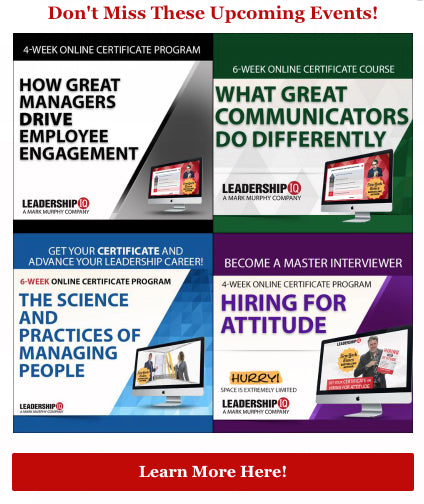The Player-Coach Philosophy That Has Nasdaq's Leaders Invested
This article originally appeared on Forbes by Mark Murphy, Founder of Leadership IQ
I regularly see leaders struggling to balance ‘leading’ and ‘doing.’ How much should leaders engage with employees and inspire them to produce great stuff? And how much should leaders roll up their sleeves and produce great stuff themselves? It’s the $64,000 question, so perhaps not too surprising that Nasdaq, a diversified global financial technology company providing trading, exchange technology, information and public company services, has an answer.
I recently sat down with Bryan Smith, SVP, Global Head of HR at Nasdaq where the core leadership ability seen across the ranks, regardless of whether a leader has 15 years or two years with the organization, is the commitment to finding that player/coach balance. “At Nasdaq, you’re definitely thinking strategically over the long term while executing on today,” Bryan said. “Our leaders instill financial discipline and are able to execute, but they also inspire their people and are part of the team. It’s an interesting combination that definitely defines the leaders who thrive at Nasdaq.”
Nasdaq’s player/coach philosophy starts at the top, with CEO Bob Greifeld. “Bob sets very clear expectations and has the respect of his direct reports,” Bryan said. “For example, If Bob asks you about why the profitability of one of your products is deviating from the budget in the latest forecast, there’s an expectation that you understand the underlying data and the profitability drivers. Our leaders are able to field such questions as they partner with their teams each day to understand and guide decisions. Depending on the size of the team, there is also the expectation that leaders will know all the senior people on their team, if not the entire team, and their skills and abilities. If you manage 100 people, you should have actually met them, it’s expected that there’s a relationship there.” This behavior instills a level of player/coach discipline that cascades through the leadership ranks of the organization and sends a message that everyone is working toward common objectives.
This sounds great, but let’s face it, it also sounds difficult. So how does Nasdaq actually strike this player/coach balance? Some of it comes from having a core team of leaders that created monster growth over the past decade—revenue has grown from $600 million to over $2 billion. With senior executive tenures averaging somewhere around 10-12 years (Bob’s been CEO for 11 years), these folks grew Nasdaq from hundreds of employees to thousands. Nasdaq has transformed itself from primarily a U.S. equities exchange to a diversified financial technology company which not only operates The Nasdaq Stock Market, which is the largest single U.S. exchange by volume traded (2 billion shares per day), but also owns and operates 25 additional exchanges and five central Security Depositories around the world. Their technology now powers more than 80 marketplaces in 50 countries and 1 in 10 of the world’s securities transactions, plus they provide over 41,000 indexes across asset classes and geographies, offer over 90 data products to investment professionals, and provide corporate services to over 10,000 clients around the globe. As a result of this growth, they’ve now got 50+ offices in 26 countries.
Don't Miss This Week's Live Webinar. . .
Mastering the Player-Coach Leadership Model
Friday, January 5th @ 1:00pm EST
Along the way Nasdaq’s leaders had to roll-up their sleeves and crank out work, while at the same time, hiring and developing all these new employees. But Nasdaq’s choice of leadership style wasn’t just happenstance; they’ve intentionally done very smart things to help their leaders master the player/coach style. Here are 5 techniques that Bryan shared with me…
- Prioritize
Like all companies, every day at Nasdaq is about prioritizing. “There’s always 15-20 critical things to do per day,” Bryan said, “and it’s a balancing act around what I can leverage other people for versus what needs my personal attention. So I need to ask myself, will there be negative consequences if I don’t step in and roll-up my sleeves right this second?” When the answer is ‘no,’ that’s a great opportunity for Bryan to develop the people on his team. But if his answer is ‘yes,’ he gets busy working; involving team members wherever he can.
One example Bryan offered was preparing for a critical presentation to the Board. “I will deliver the actual presentation. When preparing, I may open-up PowerPoint and start tweaking slides real time. But my team is right there with me doing background work, data analysis, or just learning why I changed a particular visual or message.”
One of the benefits Bryan named to being both coach and player in Nasdaq’s fast-paced environment is that hierarchy doesn’t get in the way of decision making. “All our leaders have the same mentality of let’s move key initiatives forward that advance the strategic direction of the organization.”
- Develop a leadership bench
If you’re going to use a player/coach model, you have to keep leaders from turning into individual contributors. One of the best ways to do that is to force a hard look at the leadership bench (aka succession planning). When you force leaders to identify and develop future leaders, you keep them from getting permanently sucked into the trenches.
One of Bryan’s first initiatives when he joined Nasdaq was to assess who the leaders were along with their developmental needs and succession plans. This translates to a robust review and succession planning that goes 3 levels down from the CEO (to EVPs, SVPs to VPs). “We identified core competencies for each of those roles, and then we assessed each individual relative to those competencies,” said Bryan. “We identified their strengths and opportunities, created a clear path for them, and then had them identify a potential successor who could be ready within 12 months.”
This exercise gives Nasdaq a very clear picture of their current leaders’ performance, likely successors, and developmental needs (including training, coaching, experiences, etc.). And leaders are held accountable. Bryan noted “we report to the board annually on our findings regarding executive talent, strengths, opportunities and succession plans.”
- Train leaders to act
Like most good companies, Nasdaq formally trains their leaders. But they also created a special 15-month action-learning experience for their next generation of senior leaders (mostly current Vice Presidents). Bryan told me that “these folks will lead and complete a real-life project—this isn’t some make-work exercise. And it’s a project with lots of technological and cross-functional implications, as well as very real bottom-line impact.” These VPs are being groomed for the next big opportunity, and they show their mettle on a real-life project, complete with lots of exposure to top executives, and collaboration with other high-potentials around the globe.
- Listen to your people
In too many organizations employees feel lucky if they get a “hey, how’s it going?” from their own boss, let alone the CEO. Not at Nasdaq, and once again, it starts at the top. Bryan shared with me that Bob and other senior executives regularly get in touch deep into the ranks through regular lunches with 8 to 10 employees, randomly chosen from the different business units. In this casual, face-to-face environment employees are asked ‘What do you want to talk to me about? What do you want to share with me?’ “Deep answers and insights are the result,” Bryan said. “Bob will often come in the day after one of these lunches and say ‘I heard such and such from a group of employees that are just 2 years out of college. This is the kind of thing they want. What can we do about this?’” “These active interactions through the ranks sets a precedent, in addition to generating a lot of new ideas.”
That’s not to say that being a coach in an entrepreneurial environment is easy, especially in an organization of Nasdaq’s size and complexity. “Our higher level leaders, the VPs and SVPs have teams of hundreds, or even thousands – if you consider the EVPs, too,” Bryan said. “We have to learn to delegate, to trust our people, and to not just take everything on ourselves. Because when you have that many people on your team, you can’t do it all yourself. It’s about letting go and empowering the next player down.”
- Break down silos
There are particular things Nasdaq’s leaders do to triage the daily challenges, to stay connected and to avoid the surprises that could easily happen in an organization this size. For example, the “Where Silos End Meeting” that takes place every Monday morning at 8:30. As Bryan describes it, the global leadership team gets together in the video conference room with remote offices conferencing in. “There are about 50 of us altogether in these meetings,” Bryan said. “We have different business units and we want to make sure they don’t become silos. Regular Where Silos End Meetings allow everyone to interact and collaborate; it’s where we share updates from the prior week and the priorities for the weeks ahead. And maybe most importantly, these meetings build and maintain relationships and a level of decorum and mutual respect.”
Bryan was happy to share how all this goes down in just 90 minutes. “Bob runs the meeting. he kicks it off then passes the mic and we each have about two minutes to share what’s going on in our area. It is a download of what’s important and timely. And while this is happening, we’re making sure there aren’t any internal hurdles of conflicts to get in the way.”
Conclusion
The most effective leaders are a combination of players who gets things done and coaches who tap into others’ great ideas, gets folks emotionally attached to the work, and who help their people reach their full potential. The Nasdaq team makes it work with their top down commitment to prioritizing, developing future leaders, training with real-life action-learning experiences, listening and keeping connection and collaboration vibrant. Invest in your own company using these tips.
Mark Murphy is a NY Times bestseller, author of Hiring For Attitude, and founder of the leadership training firm Leadership IQ.







